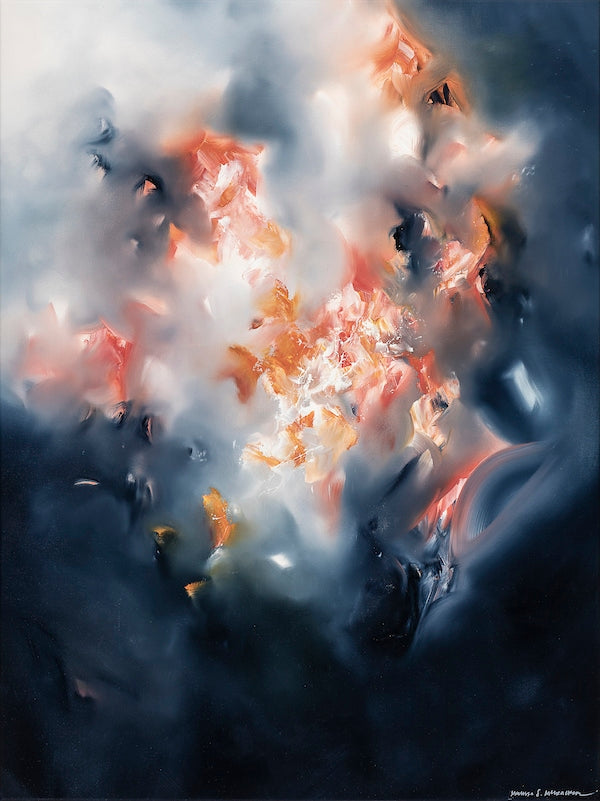In Issue 170, Melissa McCracken shared with our readership the fascinating experience of creating her artwork as a synesthetic. Here’s an excerpt from Part One of our interview:
Melissa McCracken: Synesthesia is a neurological condition in which the brain’s senses are cross-wired. So, in my case, whenever I hear music, the color faculty of my brain is triggered at the same time. it’s involuntary and simultaneous – an automatic response to music. Synesthesia can occur in a number of different ways. Any of the senses can be cross-wired. I have a form called grapheme synesthesia, in which, if I’m reading a book, all the letters and numbers are color coded as well. Spatial synesthesia is another [type that I have], where days of the week and numbers or anything that’s sequential is mapped out around my physical body or in my mind in specific places. It’s basically just my senses overlapping in a way they wouldn’t normally in a neuro-typical brain.
Our interview continues here.
Alón Sagee: This question may be a bit from left field, but, have you ever heard a favorite and familiar song played back on a high-end stereo system?
MM: My brother is big into audio gear – he’s an audiophile for sure. He’s really into music and he introduces me to new artists and lets me listen on his really good noise-canceling headphones. I don’t know what exact model they are, [and] I’m not very familiar with all of the different brands of stereo equipment. I would say, though, that I have developed a little bit of an ear for those differences in audio quality. It’s not as fine-tuned as I imagine someone like you would have, but I can definitely tell the differences.

Melissa McCracken.
AS: What kind of equipment do you listen to when you’re painting?
MM: Typically? I love, I mean, I choose headphones over having a stereo system or home theater in the room because there can be other distractions with that. I love the immersive process. I was reading the article that you had sent me [“Sublime Moments,” Issue 101] about the BBC [Symphony] Orchestra that played Ralph Von Williams’ Fantasy on a Theme by Thomas Tallis, [and] the clip showed how immersed the conductor and individual musicians were. You had mentioned that you usually have heightened experiences with music by closing your eyes while listening. I feel like the experience of listening [with] headphones is the closest that I can get to closing my eyes and shutting out something else without actually closing my eyes while I’m painting. You know what I mean? (laughs) Listening through good, noise-cancelling headphones is the most immersive way that I can be connected to the music while still being able to see what I’m doing! (laughs).
AS: How many times do you think you usually come back to a painting and listen to the song, until it’s finished?
MM: I have no idea. I’ve noticed that on my Spotify wrap-up report at the end of the year, the songs that I’m working on for a painting are usually the most-played songs, so I know that I go back to them pretty frequently. I will [first] listen to a song for maybe 30 minutes to an hour, just kind of getting familiar with it in the beginning stages of the painting, just to kind of map it out. And then after that maybe I’ll switch to something else, just to disconnect my brain a little bit and not be so caught up in what I was listening to. Then I’ll just periodically go back and forth. Some of my paintings I’ll complete in one session. That obviously [means I’m] listening to the music a little less, but [with] some of the [paintings], I’ll be working on [them] for months to really get right. Sometimes, I might restart a painting, so it can be a lot of the same song over and over until it’s complete.
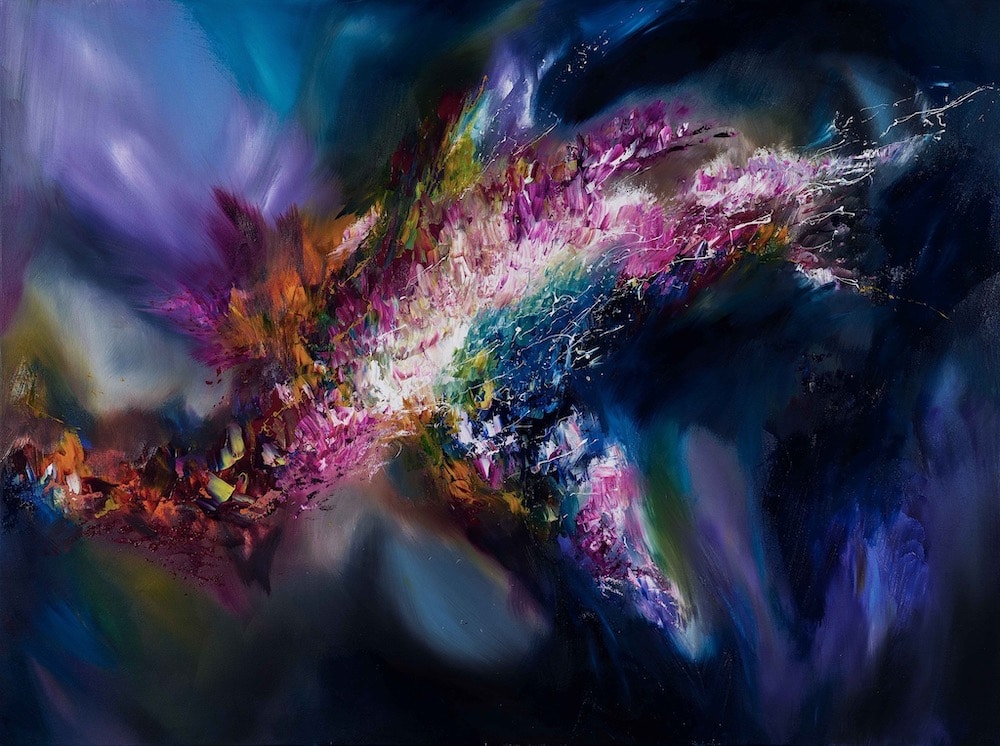
Lenny (2016).
AS: Is all of your work inspired by synesthesia in one way or another, or can you just start painting? As a reference, one of my favorite paintings of yours is called “Attentive Recognition…” Is it related to any song, or did it just emerge into your brushstrokes?
MM: A little of both.
AS: So beautiful…it’s almost painful.
MM: Oh, thank you. Thank you. That one specifically was [done] during a period when I was pulling away from directly painting music as much, but it was still inspired by music.
A lot of [my] works might be named a little bit more cryptically – usually [from] a few lyrics from random songs that I might have listened to at that time, just bits and pieces of tunes that I had accumulated as I was somewhat disconnected from [being] more immersed and meditative. I always have music on whenever I’m painting, so music is always involved, but it might just be a little more nuanced [of an influence]. Some of my work emerges from my personal feelings as I’m painting, rather than just trying to translate a musical piece.
AS: Were you trained in art in your school years?
MM: Yeah. In school I ended up being out of town at my senior art show and (laughs) missed [getting] the last credit [I needed] to graduate with a minor in art – but I did take a lot of art classes nonetheless.
AS: I think back to my love of art, especially artists that moved me with color. Do you know of any other artists, possibly someone well-known, who have or had synesthesia and used it in their work?
MM: Wassily Kandinsky is one of the big ones. He’s known as one of the fathers of abstract art and a lot of his work was related to his experiences of music, but I don’t believe it’s as outright [as what I experience]. I’m not even sure if they knew what synesthesia was at that time [Kandinsky lived from 1866 to 1944 – Ed.], but I have a book he authored and he writes about the idea of sacred connections between color, sound and shape – like a sacred geometry and color connection between everything in existence. There have been other synesthetic artists, but I think that synesthesia inspires their work rather than being a direct translation of music, which is what I experience.
AS: Yes, now it seems obvious. I remember being thrilled by Kandinsky’s use of color and shape in my college art class. It seems likely that he was a synesthete before the world’s neuroscientists knew what to call this gift you both seem to share.
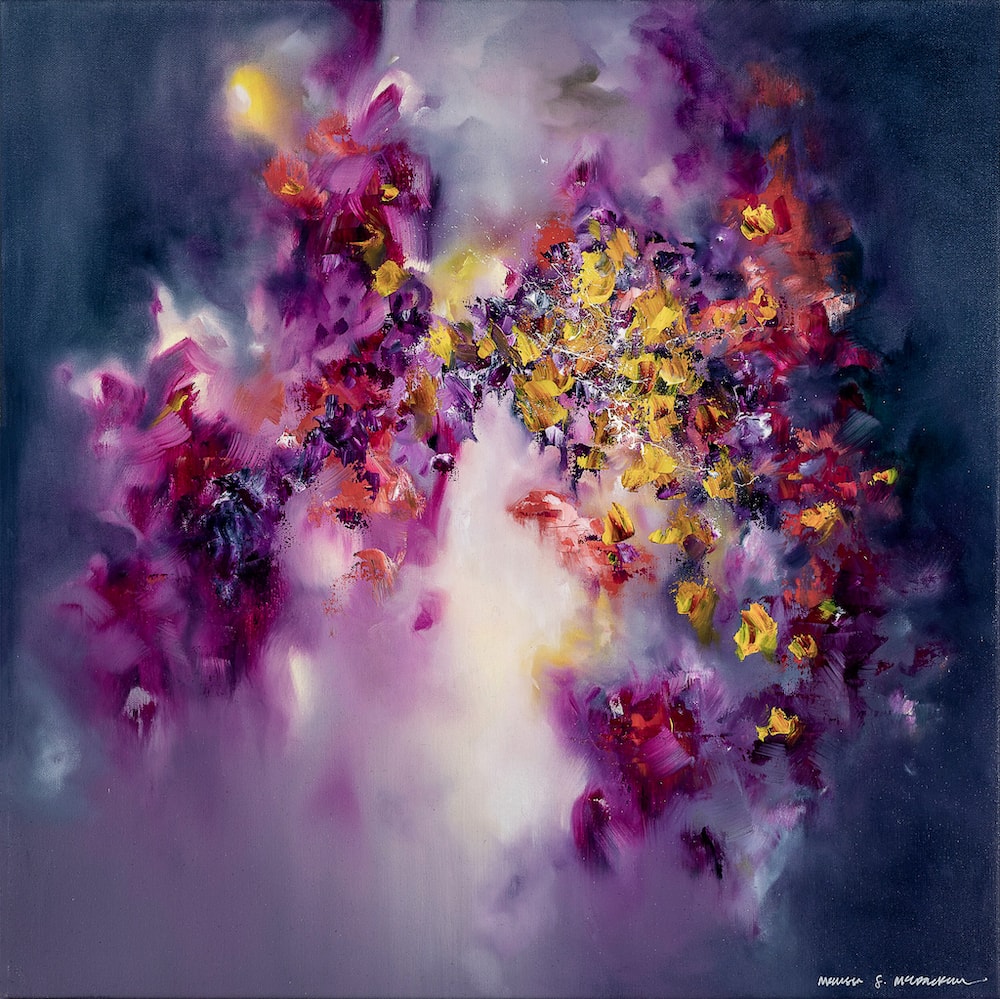
Two Drifters (2018).
Do you have a favorite genre of music that you listen to, that you like to paint to?
MM: Artists that I gravitate to are soulful in a lot of ways. I don’t [prefer] one specific genre, but in general, music that has a lot of dimension to it and a lot of feeling behind it. Stevie Wonder is one of my favorite artists. I feel like there’s a lot of honest emotionality behind what he creates. I feel the same way about Radiohead – those musical pieces with emotional dynamics alongside a lot of interesting noises and soundscapes can produce a [much] clearer image for me than something like classical music, which I don’t quite have the ear for – it’s hard to illustrate that much musicality in one song.
AS: When you meet someone new and you strike up a conversation with them, would you see colors when you heard them speak for the first time?
MM: Not necessarily. I have observed that people’s voices have a different kind of look to them, they’re not quite as vivid [as the] colors as I find in music. There’s definitely a different texture and shape to voices. But I don’t think about that as much because, since the visual is in front of me interacting with the person, there’s not as much of an auditory connection like I feel with music. There’s a little bit of something there; it’s just not very pronounced.
AS: Your painting of Bach’s Cello Suite No. 1 is really beautiful to me; “Imagine” by John Lennon is wonderful; David Bowie’s “Life on Mars?” is great; “Little Wing” by Jimi Hendrix is so good. “Karma Police” by Radiohead… the way you transform these into light and color is remarkable.
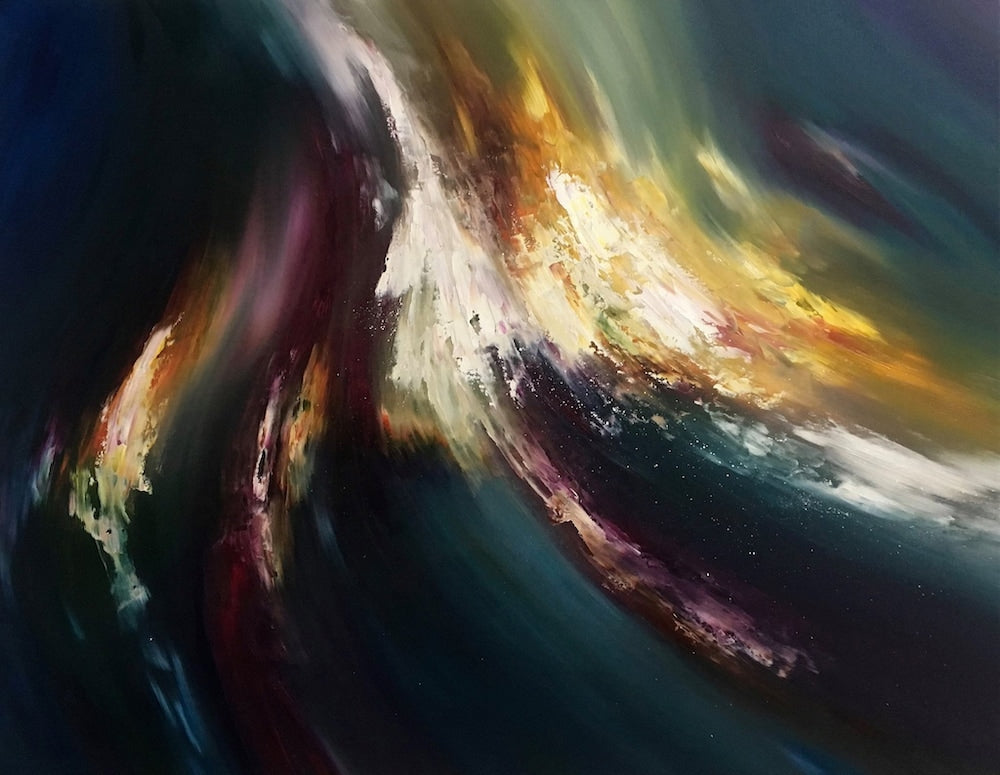
Bach Cello Suite No. 1 (2016).
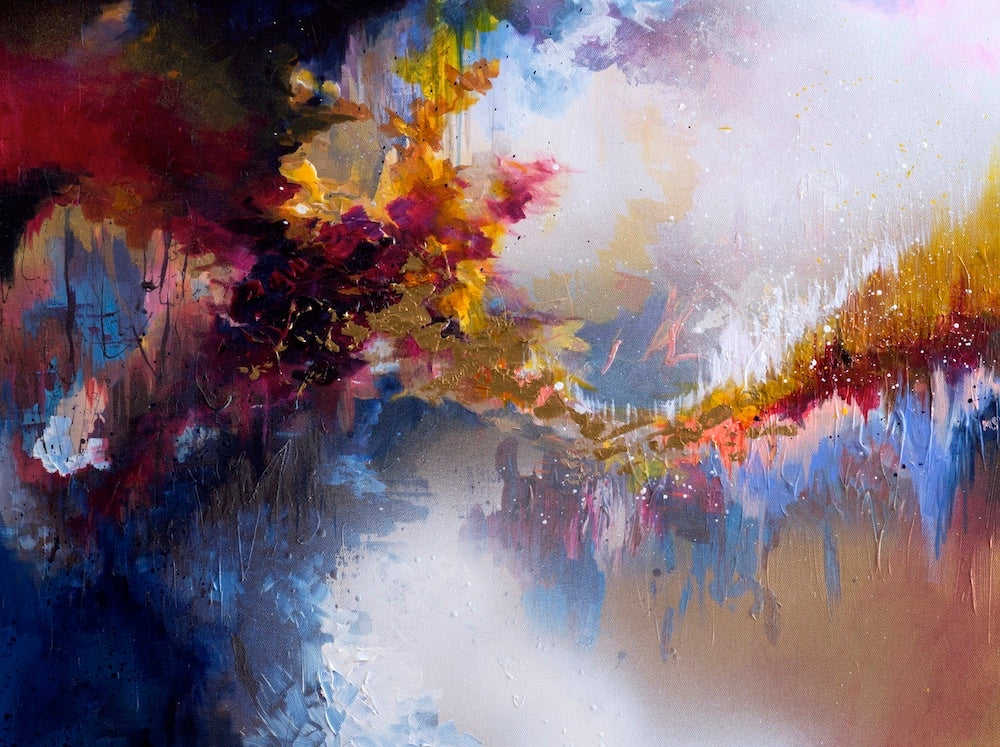
Imagine (2016).
MM: Thank you. I appreciate that.
AS: What else do you think our audiophiles would want to know about your work?
MM: I’ve been thinking about that. I will say the cool thing about my experiences with synesthesia is knowing the connection that music can have just across the board into other things. Like how it informs so much of what we experience, like the power of soundtracks in movies. I feel like the thing that I’ve appreciated about what I do is that it just might bring music lovers into experiencing a little more of the visual art side of things.
I also enjoy seeing the subjective experiences that people have with music or visual art. It’s been a really interesting journey to see how sentimental and emotional and just how vital music can be in people’s lives, and I think that it’s great for all of us to reflect on the breadth and width of our own musical interests. I feel like I’ve done that a lot since starting [to] paint and seeing how I connect to music in that way.
AS: I just had a thought. I would love to see two synesthetic painters with identical blank canvasses and easels face each other so they can’t see each other’s work, and both put on high-quality headphones, play a mutually agreed upon piece of music, and see what comes up for each artist.
MM: I did something like that on the Jimi Hendrix painting of “Little Wing.” I met a woman, Poppy Porter, online, [who has] synesthesia. [She’s] based in England and would do sketches of things just to get ideas for her paintings. So, I asked her if she would sketch out “Little Wing.” What she came up with [had] an entirely different look. The shapes, the textures, everything. And that kind of goes back to what I was saying, that it shows that there are such strong personal connections to art because synesthesia is also subjective. No one will have the same sort of interpretation. it’s really cool to see the differences between peoples’ visual interpretations of music.
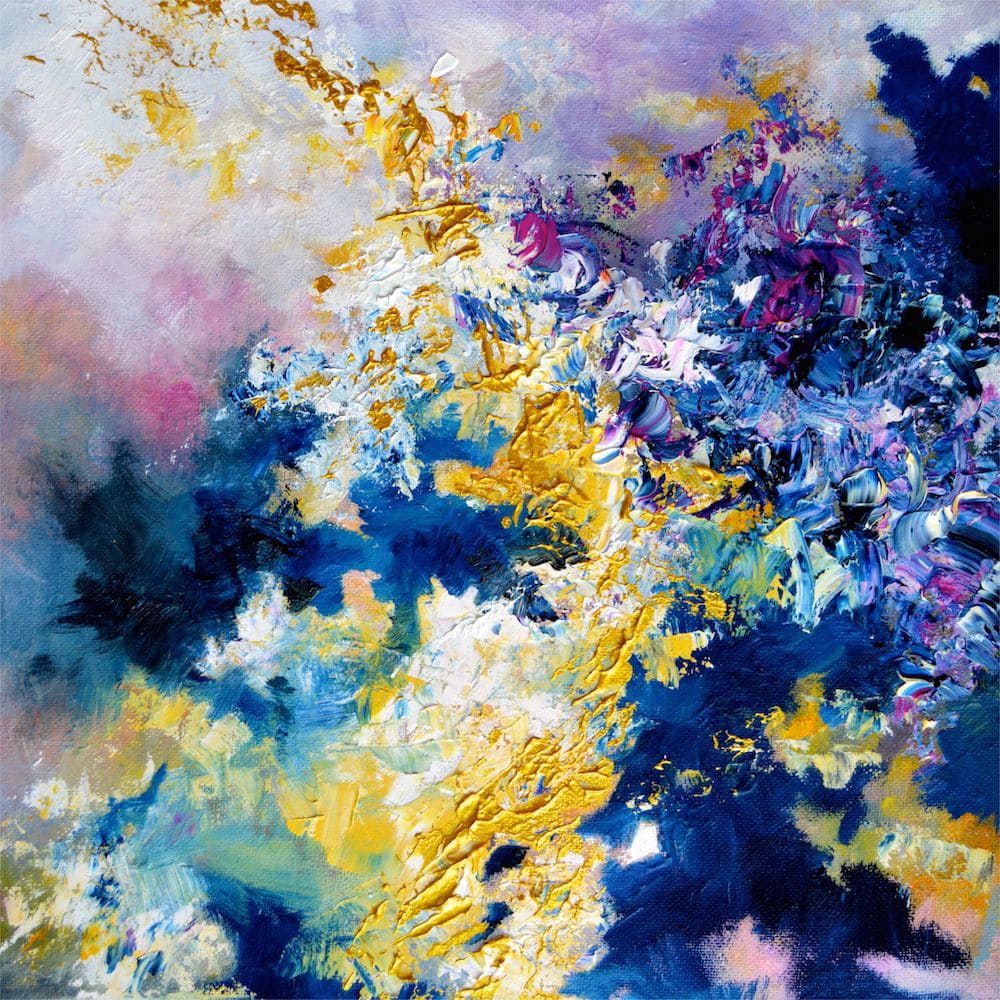
Little Wing (2014).
AS: Which are your all-time favorite or most important pieces?
MM: I feel very connected to “Little Wing.” I remember listening to my brother learn how to play the guitar growing up. He started playing really young and he’s quite a bit older than me. I’d go into his room and he’d be playing Jimi Hendrix or Stevie Ray Vaughn, so all of those early associations with those visuals are connected to very sentimental moments in my life with people that I love. I think a lot of that connects me to some pieces more, because of those experiences in life.
I also did a piece called “Two of Us On the Run,” [based on the song by Lucius] another favorite of mine. My dad was battling cancer years ago. He passed away in 2019, but there were some lyrics in that song that felt very hopeful, very oriented towards pushing through and persevering. So, I created that piece in connection to him and that feels very special to me.
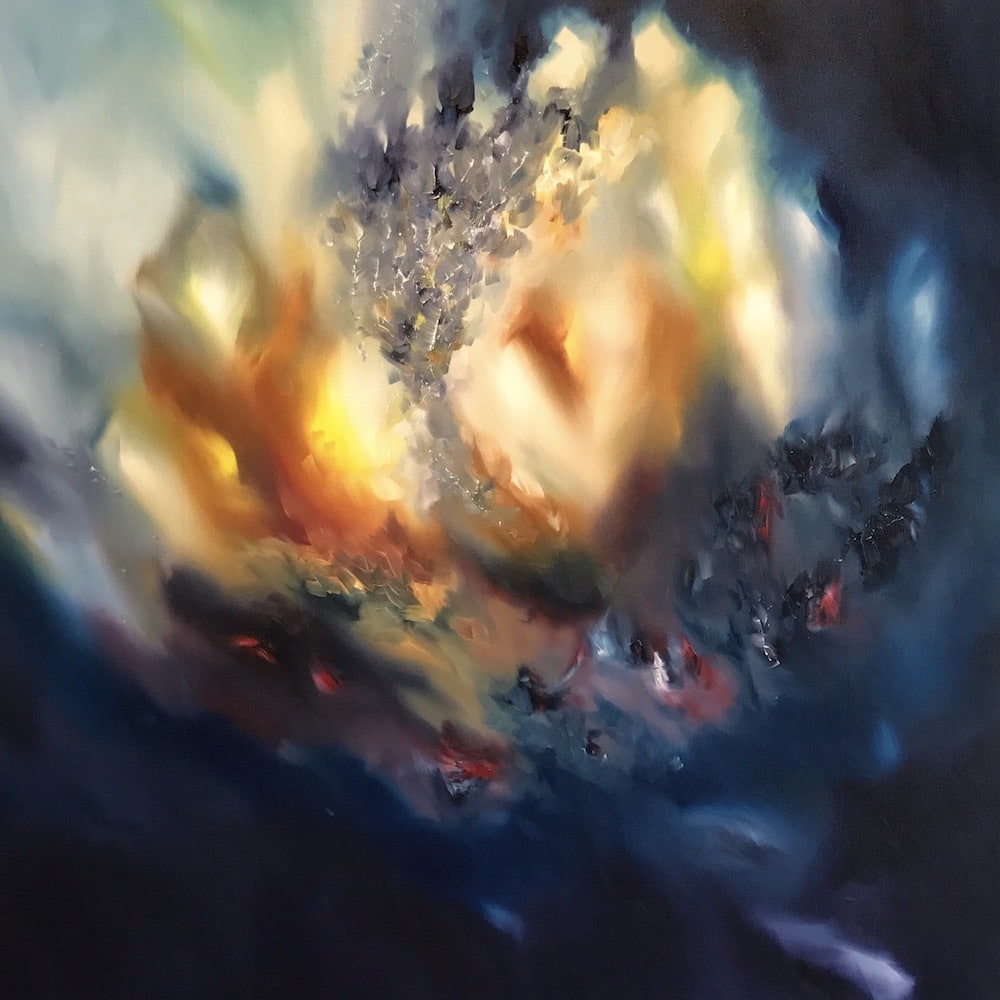
Two Of Us On the Run (2018).
I think that music is the soundtrack of our lives. Whenever something really hits me, relative to what I’m experiencing, or just something that’s just beautiful and [that] I really connect to, those are always the paintings that I feel closest to, almost even regardless of how they turn out or what they look like.
AS: Do you ever paint without experiencing the synesthesia? Can you do that?
MM: Yeah; I’ve painted my entire life and I’ve always been really interested in art, even before knowing that I had synesthesia. I’ve done portraits random sketches, watercolors, all different modalities. That is inspiration for my musical work, because I can see the connection between what I’m creating and my mind, like, “Oh, that reminds me of something that I heard in this song.” And these connections can go from one to another. I do like [to] just play with color and texture just to see where a foundation might come up, and maybe later connect that to something else or incorporate it with a new piece later.
AS: Melissa, It’s been a pleasure getting to know you and your wonderful art.
MM: Thank you so much. I appreciate it.
Here’s the full list of Melissa’s paintings inspired by music: https://www.melissasmccracken.com/song-list
******
Copper Community Engagement:
Has one or more of the paintings inspired by a piece of music touched you in some way? Please share your experience by submitting a comment.
Alón Sagee is Chairman and Chief Troublemaker of the San Francisco Audiophile Society. Alón’s writings for Copper can be found in the following issues:
- The Colors of Music: Synesthetic Artist Melissa McCracken Sees and Paints What She Hears, Part One
- A Pre-Entry-Level Analog MP3 Killer
- The Audiophile’s Opinion/Audio Clubs
- The Audiophile’s Brain
- The Audiophile’s Cat
- Chinese Food for Thought
- The Not-So-Great Wall
- Everest, Part 1
- Everest, Part 2
- Everest, Part 3
- Mongolia, Part 1
- Mongolia, Part 2
- Two Hands Clapping
- Sublime Moments
Also, please note: Alón’s biography for the San Francisco Audiophile Society.
Header image: La Mer (2018).

